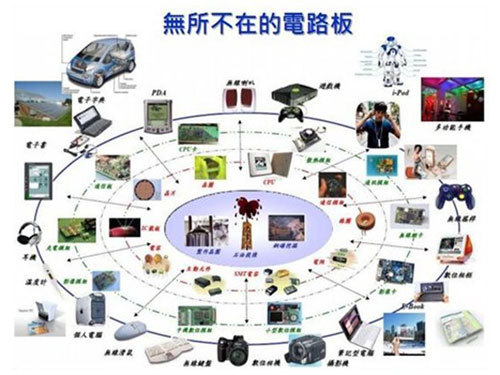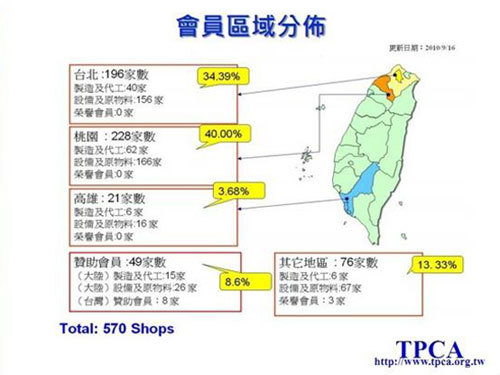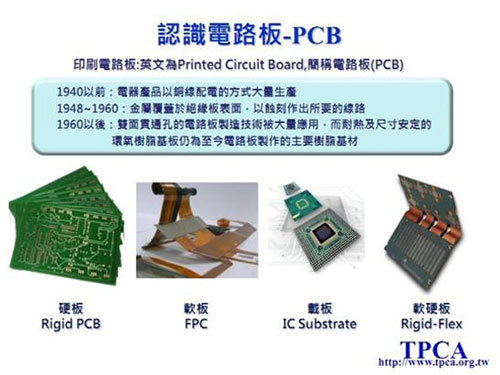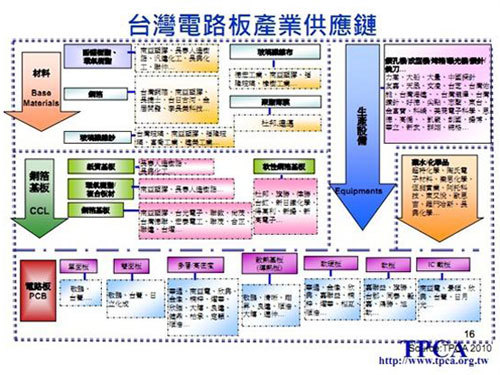PCB industry analysis report
Release Time:
2013-04-18 00:00
1, PCB board concept
PCB is (Printed circuit board) printed circuit board for short, usually in insulation material, according to the scheduled design, made of printed circuit, printed components or a combination of the conductive graphics known as printed circuit. A conductive pattern that provides electrical connections between components on an insulating substrate is called a printed line. In this way, the printed circuit or printed circuit of the finished board called printed circuit board, also known as printed board or printed circuit board.
2, PCB industry chain and competitiveness analysis
(1) Analysis of PCB industrial chain
PCB board is the base board for assembling electronic parts. It is a printed board that forms point-to-point connections and prints components according to a predetermined design on the general substrate. The main function is to make a variety of electronic components form a predetermined circuit connection, plays the role of relay transmission, is the key electronic interconnection of electronic products. The manufacturing quality of PCB board not only directly affects the reliability of electronic products, but also affects the overall competitiveness of system products. Therefore, PCB board is called "the mother of electronic system products". The development level of PCB board industry can reflect the development speed and technical level of electronic industry of a country or region to some extent.
Glass fiber yarn: glass fiber yarn is calcined into liquid state by silica sand and other raw materials in kiln, then drawn into very fine glass fiber by very fine alloy nozzle, and then twisted into glass fiber yarn by several hundred glass fibers. Kiln construction investment is huge, for the capital intensive industry, 30,000 tons of kiln needs 400 million yuan, new kiln needs 18 months, the business cycle is difficult to master, and once the ignition must be 24 hours uninterrupted production, and after five years or so, must stop production for half a year maintenance, enter and exit the cost is huge.
Glass fiber cloth: Glass fiber cloth is one of the raw materials of copper clad plate, made of glass fiber yarn textile, accounting for about 40% of the cost of copper clad plate (thick plate) and 25%(sheet). Glass fiber cloth manufacturing and weaving enterprises are similar, can control the speed to control the production capacity and quality, and the specifications are relatively single and stable. Unlike CCL, the price of fiberglass cloth is most affected by supply and demand, and has fluctuated between $0.50 and $1.00 / m in recent years. Taiwan and China now account for about 70 per cent of global production. The upstream and downstream relationship for the operation of the key, the price of a loom is 100,000-150,000, generally more than 100 sets of normal production, but the subsequent heat treatment and chemical treatment equipment capital requirements, up to ten million level, weaving capacity expansion is easy, more flexible. For example, Shanghai Honghe Electronics under Taiwan Hongren Group, all the looms used by the enterprise are Toyota of Japan, with large quantity, dense weaving number, high production capacity, good performance and good product quality.
Copper foil: Copper foil is the raw material accounting for the largest proportion of the cost of copper clad plate, accounting for about 30% of the cost of copper clad plate (thick plate) and 50%(sheet) above, so the price rise of copper foil is the main driving force of the price rise of copper clad plate. Copper foil is widely used, not only in the copper clad industry, when the copper clad industry is depressed, copper foil manufacturers can switch to other uses of copper foil production. The price of copper foil is closely reflected in the price of copper. With the rising price of copper, copper foil manufacturers transfer the cost pressure to the downstream. The high technology barrier of copper foil industry leads to the lack of domestic supply, high-grade copper foil still needs a large number of imports, and the cost of investment is also very large.
Copper coated plate (CCL for short) : It is made of electronic grade glass fiber cloth as the base material, soaked in epoxy resin, dried and made into semi-cured bonded sheet, and then coated with thin copper foil on one side, two sides or multi-layer board, and made under special hot pressing process conditions. It is the direct raw material of PCB. The capital demand of the copper clad industry is large, and the small scale factory is about 50 million yuan. The copper cladding industry is a cost-driven cyclical industry. In the upstream and downstream industrial chain structure, CCL has strong bargaining power for PCB. As long as the downstream demand is reasonable, the pressure of rising cost can be transferred to the downstream PCB manufacturers. Because of the single use of copper-clad products, they can only be sold to PCB factories. When PCB is depressed, they can only lower the price to ensure the utilization of capacity.
PCB: Compared with upstream and downstream industries, PCB industry characteristics determine its industrial concentration is not high; In the fierce market competition environment, only those enterprises with good market positioning and high operation efficiency can have long-term competitiveness. An ordinary PCB production line needs more than 20 million yuan, multi-layer board needs 50 million yuan, and HDI needs more than 200 million yuan. Due to the huge industry, the division of labor is very fine, there are specialized in drilling and other single station process outsourcing, low-grade products oversupply. HDI and other high-end PCB industries belong to the capital and labor intensive industry, the management and technology requirements are relatively high, often become the bottleneck of capacity expansion.
(2) Analysis of PCB industry competitiveness
At present, the output value of the global PCB industry accounts for more than a quarter of the total output value of the electronic component industry, and it is the largest industry in each electronic component subdivision. At the same time, due to its unique position in the electronic basic industry, is also the most active industry in the contemporary electronic component industry, PCB board in the overall output value of the electronic component shows an increasing trend, because with the adjustment of the product variety structure, printed circuit board in a single final product required area is gradually reduced, but due to the improvement of precision and complexity, In the overall cost of PCB value proportion has increased, is the main pillar of the development of electronic components industry. In the electronic component industry, the PCB industry is only second to the semiconductor industry in terms of output scale, and its importance is growing with the expansion of PCB applications. The PCB industry's average gross profit is around 20%.
1. Competitors
Competition among peers is fierce: enterprises in the industry are divided into three levels: high, medium and low. The middle and high end are dominated by foreign, Hong Kong-funded, Taiwan-funded and a few state-owned enterprises, while domestic enterprises are at a disadvantage in capital and technology.
2. Substitutes
PCB board has been widely used in a large number of electronic products, but there is no mature technology and products that can replace printed circuit board. The basic manufacturing process of PCB "reduction method" has not changed significantly in recent decades; That is, using the way of screen printing to etch metal to get PCB, which is the origin of the name printed circuit board. Because this production process is not environmental protection, the production of waste water, waste gas is more, at present, there are many institutions began to develop and traditional circuit board production method is fundamentally different from other processes, such as inkjet circuit board, lithographic circuit board, etc.
Epson's "inkjet technology", PCB, uses liquid metal instead of ink to spray it out of the print head and spray the necessary material into place to form a metal film. Using "liquid film" technology, a circuit pattern on a chip can be drawn as if it were a picture printed on a printer. Compared with the traditional "photographic plate technology", the PCB production process based on inkjet technology has many advantages. Because the circuit is molded only where it is needed, it can save a lot of material; Because the whole process is a dry treatment process, no waste liquid is produced, and the reduction of production steps reduces energy consumption. It is also suitable for high mixing, small batch production and multi-layer structure production.
3. Potential entrants
The rise of Southeast Asia, which has attracted a lot of foreign investment due to lower labor and environmental costs than China; India, in particular, has a great demand for PCB in its own market. Low-end products such as single and double-sided PCB have low entry cost and less investment, and manual workshops can survive at low cost.
4. The power of suppliers
Copper coated plate, copper foil, semi-cured sheet, chemical liquid, anode copper/tin/nickel, dry film, ink and other products are the main raw materials required for PCB production. Raw material costs accounted for 66% of costs, respectively. In recent years, the cost of raw materials has increased greatly due to the sharp rise in the price of oil and non-ferrous metals. Copper clad plate accounts for about 40% of the entire production cost of PCB, which has the greatest impact on the cost of PCB. Large scale PCB companies will sign long-term contracts with copper clad plate plants. Reduce the impact of raw material price fluctuations.
3. Analysis of current situation of domestic PCB industry
From a statistical point of view, the PCB industry is now very prosperous, but in fact it has encountered more difficulties. On the one hand, the industrial transfer of developed countries creates prosperity and raises the level. On the other hand, after reaching the peak of the stage, the problems brought by development become apparent. The capital that restricts progress, such as space, labor, water and electricity, and environment, is no longer cheap. The PCB industry is gradually moving to the central and western regions due to the impact of cost and downstream industries.
(1) Analysis of China's growth trend
The demand for downstream products promotes the development of the industry itself, and the industry is transferred from developed countries to China. However, due to the consideration of environmental protection, China restricts low-end products below 4 layers and encourages high-end products such as HDI. These factors jointly promote the development of PCB to high-end products. In 2010, the output value of PCB in China exceeded 18.5 billion US dollars, with an annual growth of 30%. The PCB industry as a whole has developed rapidly, and the rapid development of electronic terminals such as tablet computers and smart phones has promoted the development of PCB. According to the Q4 2010 report, the global output of PCBS in 2010 was $51 billion, up 24% from 2009, and the PCB industry is now almost back to its all-time output level in 2008. As the manufacturing center of PCBS in the world, the PCB industry in China remains a major growth driver driving the development of the global PCB industry.
(2) Analysis of China's PCB production capacity
Due to the consideration of comprehensive strategic layout, major PCB manufacturers of various countries have set up production capacity in China, and China has become the world's largest PCB supplier. In the last 1-2 years, PCB manufacturers in Europe and the United States have been shutting down factories due to cost pressure and transferring orders to China, which directly promotes the continuous growth of PCB production capacity in China in recent years.
(3) Analysis of PCB product structure in China
The specifications of PCB board are more complex, and there are many kinds of products. Generally, PCBS can be classified according to the number of layers, softness and material. According to the number of layers can be divided into: single panel, double panel and multi-layer board; According to the softness can be divided into rigid printed circuit boards and flexible printed circuit boards.
According to the number of PCB layers and development direction, the PCB industry is divided into six main product segments, such as single panel, double panel, conventional multilayer board, flexible board, HDI(high density interconnection) board and packaging substrate. From the perspective of four cycle dimensions of product life cycle, such as "introduction period - growth period - maturity period - decline period", single panel and double panel are in the decline period because they are not suitable for the current application trend of short and thin electronic products, and their output value proportion is gradually decreasing. Developed countries and regions such as Japan, South Korea and Taiwan have rarely produced such products in their own countries. Many big factories have made it clear that they will no longer connect single and double panels.
Conventional multilayer board and HDI are mature products with increasingly mature technological capability and high added value. At present, most of the major PCB factories are focusing on the direction of supply, and only a few domestic manufacturers such as ultrasonic electronics have mastered the production technology. Flexible plate especially high density flexible plate and rigid combined plate due to the current technology is not mature, has not been able to achieve a large number of manufacturers mass production, belongs to the growth stage of the product, but because it is more suitable for digital products than rigid plate characteristics, flexible plate growth is very high is the future development direction of each big factory.
IC used packaging substrate, whether R & D or manufacturing in the electronics industry developed countries in Japan, South Korea relatively mature, but in the domestic technology is still in the stage of exploration, only Yifeielectric (Beijing) Co., LTD., ASE semiconductor (Shanghai) Co., LTD., Zhuhai Doumen super Yi Electronics Co., Ltd. and other few manufacturers in small batch production.
Domestic hard board (single panel, double panel, multilayer board, HDI board) accounted for 83.8%, in which more than 50% of the multilayer board accounted for the largest proportion, followed by soft board with 15.6% proportion.
At present, there are more than 1300 PCB manufacturers in China, including equipment and material manufacturers. The overall size of the enterprise is the advantage of the foreign-funded enterprises. In terms of investment scale, production technology, output value, the foreign-funded enterprises are stronger than the general state-owned enterprises and collective enterprises. The printed circuit industry in China is mainly distributed in the southeast coastal areas, which is also related to the large demand of PCB industry for water. Water resources in these areas are relatively rich, and the Yangtze River Delta and Zhuhai delta together account for 90% of the national total. At present, the ratio between the Yangtze River Delta and the Pearl River Delta is about 1:1.
Communication products account for 70% of the mainstream application field of PCB in China, among which, under the situation of market demand upgrading, major big manufacturers continue to increase their size and production, the mobile phone board takes the first place with 19.3%. The photovoltaic board market with small market size is dominated by Japanese and Taiwanese manufacturers, among which the Taiwanese manufacturers focus on hard board, and Japanese businessmen mainly supply soft board.
High-density multilayer, flexible PCB has become a bright spot in the development of circuit board industry. In order to comply with the development trend of multi-function, miniaturization and lightweight of electronic products, PCB requirements of the next generation electronic system are high density, high integration, encapsulation, micro-refinement and multi-layer.
PCB varieties such as HDI board, flexible board, IC packaging board (BGA, CSP) will become the main growth point. The whole market presents two characteristics: one is with the popularity of digital products, flexible plate annual growth rate of more than 5 percent, become the focus of the market; Second, with the development of automobile industry, automotive electronics will further promote the development of HDI flexible plate special substrate.
4. Market conditions of copper-clad plate
Copper foil substrate (CopperCladLaminate; CCL is the main material of printed circuit board, accounting for 50%~70% of PCB raw material cost depending on the number of layers. The manufacturing system of CCL combines reinforcing materials (glass fiber cloth, insulating paper, etc.) with impregnated resins (epoxy resin, phenolic resin, polyimide resin...). After cutting, attached copper foil on one side or two sides, and formed into copper foil substrate by hot pressing. Copper foil substrate can be divided into various substrates with different characteristics according to different materials, including paper substrate, composite substrate, and glass fiber epoxy substrate. Paper substrate strength is poor, for low-order products, generally used in television, audio and other household appliances, composite substrate inner layer film with insulating paper or glass fiber mat impregnated with epoxy resin, also used in household appliances.
Glass fiber epoxy substrate is made of epoxy resin, glass fiber cloth and copper foil, which are immersed and pressed together. Including G-10, FR-4, FR-5 and so on, among which FR-4 is the largest copper foil substrate industry output and demand, FR-4 substrate is widely used in computer components and peripheral equipment. For example, the motherboard, hard disk drive and other products used in the printed circuit board are made of FR-4 substrate processing.
Take ordinary TG4mil core board (sheet) as an example: raw materials account for 80%, water and other, labor, depreciation are 8%, 8%, 4% respectively; Subdivided raw material composition, copper foil accounted for 63% of the production cost, glass cloth accounted for 10% of the production cost, resin accounted for 7% of the production cost, it can be seen that the price rise of raw materials, especially the price rise of copper coated plate has a great impact.
As the world's major PCB manufacturers have set up factories in China, the industrial agglomeration effect has brought great opportunities for the development of domestic upstream and downstream PCB manufacturers. Copper-clad board is the circuit bearing base of printed circuit board, which is the main component of most electronic products. The concentration of CCL is relatively low compared with that of foreign countries, but it is still relatively high compared with PCB. Among the major copper-clad enterprises in the world, 8 of the top 10 companies are based in foreign countries, and only 2 companies are based in China. Among these enterprises, Japan accounted for 3, Europe and America accounted for 2, Taiwan accounted for 2, South Korea accounted for 1, especially in Japan, the United States, Europe, South Korea, its 1~2 companies accounted for more than 50% of the main sales volume of the whole country and region, showing a strong intensity, In comparison, there are nearly 113 enterprises producing copper-clad plates in China, and an average enterprise accounts for less than 0.3% of the global share. On the one hand, China is a major producer of copper-clad plate, with the largest number of copper-clad plate manufacturers in the world. On the other hand, however, it is also exposed to the pressure of insufficient supporting facilities, weak technology book and rising cost, and the differences between enterprises caused by different product structure and technology content. At present, China's copper clad industry is: although the quantity is large but the value is low, the industry is strong and the enterprises are weak, which provides opportunities for the development and integration of copper clad enterprises.
5, the production process of printed circuit board
Divided single - layer board and multi - layer board, the process is not the same.
Single-layer plate: blanking - pressing - drilling - copper plating once - outer exposure - copper plating twice - outer etching - wet film - text - cutting plate molding - test - final inspection - packaging out of storage
Multilayer board: blanking - inner layer exposure - inner layer etching - inner layer repair - Browning - pressing - edge fishing - drilling - copper plating once - outer layer exposure - copper plating twice - outer layer etching - wet film - text - gold plating - tin spray - cutting plate molding - test - final inspection - packaging out of storage
6. How does Gaochun Development Zone attract investment around PCB industry
Based on the current ecological environment and sewage discharge standards in Gaochun, I personally think that the development zone is only suitable to recruit about two PCB manufacturers, and the scale, grade and product quality of the enterprises should be in the high-end position in the whole PCB board industry, and then we can attract investment around this industry.
Upstream PCB enterprises have high energy consumption (water, electricity), large amount of labor and low added value. I think we can attract investment by focusing on the downstream enterprises of PCB (PCB is the cornerstone of the electronics industry), aiming at the listed companies in Taiwan such as laptop, digital camera, digital photo frame, mouse, wireless keyboard, automotive navigation, automotive electronic parts and other Fortune 500 companies to attract investment.
Attached: PCB Industry Chart of Taiwan (2010 latest data)






Recommended News



